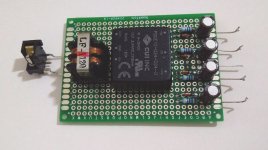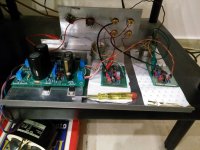I finally managed to de-bodge my prototype PCB and do some testing.
Everything looks fine, except that I'm getting a small imbalance between the two channels in the DC offset that I am getting in the outputs.
One channel is OK, outputting close to 0mV. The other channel has about 1mV offset on the OUT-DB header which gets amplified to about 9mV on the output. It's like there's something wrong with the DC servo.
All DC offset testing was done with the input shorted to GND.
Any ideas?
Everything looks fine, except that I'm getting a small imbalance between the two channels in the DC offset that I am getting in the outputs.
One channel is OK, outputting close to 0mV. The other channel has about 1mV offset on the OUT-DB header which gets amplified to about 9mV on the output. It's like there's something wrong with the DC servo.
All DC offset testing was done with the input shorted to GND.
Any ideas?
I would think its about the intrinsic offset of IC2 per sample and section. Have you got another to replace on the higher offset channel?
If my guess holds water, then I had a lucky strike 0.000V offset on the proto as you had on one of your channels.
You were absolutely right. I swapped the op-amps (IC2) between the channels and the elevated offset also switched channels. So it seems to be the intrinsic offset of the op-amps.
I can definitely live with ~8mV of DC offset, since my DCG3's DC servo will easily take care of that.. but the temptation to go parts hunting for the perfect 2134 is strong.. 😀
I can definitely live with ~8mV of DC offset, since my DCG3's DC servo will easily take care of that.. but the temptation to go parts hunting for the perfect 2134 is strong.. 😀
Or for equivalents. There is a DIP-8 socket option we put on the board for a reason. Unashamed op-amp rolling that is. Just imagine for best offset average between samples and as subjective sound winner emerges the TL-082 in the end! LOL.
That would be an epic plot twist.. Like a fellow around here says, "More distortion to the people" 😀
In my pcb though offset is very low, 0.15 mV on one channel and 0.50 mV on the other.
You won the IC2 offset lottery straight away it seems 😉
@dimdim
When doubling the servo resistor's value from 330k to 680k it will make more of near DC attenuation.
I don't know, if you got any SMD resistors collection including that value maybe pick one with the tweezers and replace the original in the wilder channel to see what happens with your offset. If it proves a good move match it to the other channel as well. So they will have the same curve details no matter if it was already 0mV successful.
When doubling the servo resistor's value from 330k to 680k it will make more of near DC attenuation.
I don't know, if you got any SMD resistors collection including that value maybe pick one with the tweezers and replace the original in the wilder channel to see what happens with your offset. If it proves a good move match it to the other channel as well. So they will have the same curve details no matter if it was already 0mV successful.
Yeah, I should have had a coffee first. Around half the R3's original value I should have suggested, not double 

Salas,
Would you recommend using AD8429 as diferential summator / buffer In audio stages like http://www.ti.com/lit/ds/symlink/pcm1794.pdf p 20, figure 24 - can we swap LT1028 for better results
Would you recommend using AD8429 as diferential summator / buffer In audio stages like http://www.ti.com/lit/ds/symlink/pcm1794.pdf p 20, figure 24 - can we swap LT1028 for better results
Last edited:
The Agricultural Edition Sessions
So I made a second channel proto board copy and slapped everything on an aluminum L frame complete with crocodile clips grounding and precarious power line arrangements. In contrast to the SMD PCB that DimDim and VGeorge are almost finished with, this must surely be called the agricultural edition. 😀
Had the Folded Simplistic Phono (FSP) nearby, and a friend's second pair of ears who came visiting with few new (thus quiet) records he had just bought. Mainly acoustic blues and classical.
First we played through the FSP. Nails the feeling. Great musicality and naturalness, layering, dynamics, width, depth, focus, splendid sound. Gain 63dB, cart AT33PTG/II straight in.
Then we put the Chipo on but starting with SMPS (IBM 15V laptop adapter to +/-24V DC/DC to RCZ +/-15V dual branch outputs). It showed some potential but the PSU must have been holding it back. Had dynamics still a ghostly thin haze was lurking at the back and a hint of contrived instrumental tone was there. Bass good but not so well driving. No hum no buzz. Looked very clean via FFT on the bench before taking it to the rack anyway. Gain 62dB in combination with Jensen JT-44K-DX step up transformers.
Was time for linear PSU. UltraBiB 1.3 at +/-15V with 200mA current limit set per rail. AC inputs fed from a Selectronic 18-0-18 R-Core (that brand's gone bust). Big difference. More sound jumped out in the room. Rich with many details but non aggressive too. Depth and slam were added. Does not quite have the spot on naturalness or the intricate layering of the FSP but good. For a chipo job very good really. No hum no buzz again but even less audible hiss up close. Not showing less hiss on the FFT in the audio band when using the UltraBiB vs the switching PSU but the hundred's of kHz high and complex noise must have been adding as a total.
Wait, there's more. What about the subjective influence of IC2 2nd stage? Out went the OPA2134 in went the AD823. You bet they are influential. I preferred the AD823. Less bodily but more natural. Noticeably so. Especially on voices freedom and stringed bass phrasing. With the opa a rather pompous sonic, maybe more at home with things like Yello's Toy album that we also gave it a spin. Measurement wise they virtually didn't differ for THD in this job. On noise grass they were alike again, although they got different nVrtHz spec, that's because they are smothered by the input stage's performance anyway.
All in all for such accessible level of effort and cost its a no-brainer. Highly dynamic, quiet, clean, full, and surprisingly smooth. Just always feed it from some type of good PSU.
So I made a second channel proto board copy and slapped everything on an aluminum L frame complete with crocodile clips grounding and precarious power line arrangements. In contrast to the SMD PCB that DimDim and VGeorge are almost finished with, this must surely be called the agricultural edition. 😀
Had the Folded Simplistic Phono (FSP) nearby, and a friend's second pair of ears who came visiting with few new (thus quiet) records he had just bought. Mainly acoustic blues and classical.
First we played through the FSP. Nails the feeling. Great musicality and naturalness, layering, dynamics, width, depth, focus, splendid sound. Gain 63dB, cart AT33PTG/II straight in.
Then we put the Chipo on but starting with SMPS (IBM 15V laptop adapter to +/-24V DC/DC to RCZ +/-15V dual branch outputs). It showed some potential but the PSU must have been holding it back. Had dynamics still a ghostly thin haze was lurking at the back and a hint of contrived instrumental tone was there. Bass good but not so well driving. No hum no buzz. Looked very clean via FFT on the bench before taking it to the rack anyway. Gain 62dB in combination with Jensen JT-44K-DX step up transformers.
Was time for linear PSU. UltraBiB 1.3 at +/-15V with 200mA current limit set per rail. AC inputs fed from a Selectronic 18-0-18 R-Core (that brand's gone bust). Big difference. More sound jumped out in the room. Rich with many details but non aggressive too. Depth and slam were added. Does not quite have the spot on naturalness or the intricate layering of the FSP but good. For a chipo job very good really. No hum no buzz again but even less audible hiss up close. Not showing less hiss on the FFT in the audio band when using the UltraBiB vs the switching PSU but the hundred's of kHz high and complex noise must have been adding as a total.
Wait, there's more. What about the subjective influence of IC2 2nd stage? Out went the OPA2134 in went the AD823. You bet they are influential. I preferred the AD823. Less bodily but more natural. Noticeably so. Especially on voices freedom and stringed bass phrasing. With the opa a rather pompous sonic, maybe more at home with things like Yello's Toy album that we also gave it a spin. Measurement wise they virtually didn't differ for THD in this job. On noise grass they were alike again, although they got different nVrtHz spec, that's because they are smothered by the input stage's performance anyway.
All in all for such accessible level of effort and cost its a no-brainer. Highly dynamic, quiet, clean, full, and surprisingly smooth. Just always feed it from some type of good PSU.
Attachments
- Home
- Source & Line
- Analogue Source
- Chipomatic balanced input RIAA

